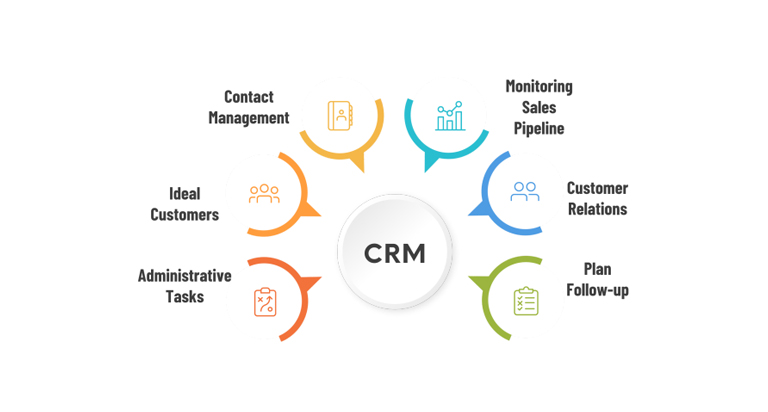In today’s competitive business landscape, customer satisfaction is paramount to success. Proactive Customer Relationship Management (CRM) tools are revolutionizing the way companies engage with their customers, offering a strategic edge in building lasting relationships.
By anticipating customer needs and addressing issues before they arise, these tools not only enhance the customer experience but also drive loyalty and retention.
This article explores the benefits and practical applications of proactive CRM tools, providing insights on how businesses can leverage them to meet and exceed customer expectations in a dynamic market.
Boost Customer Satisfaction with Proactive CRM Tools
In the competitive landscape of today’s business environment, customer satisfaction is paramount. Proactive CRM (Customer Relationship Management) tools play a crucial role in enhancing customer experiences by anticipating their needs and addressing issues before they arise.
By leveraging these tools, businesses can build stronger, more loyal customer relationships, leading to increased customer retention and revenue growth.
Understanding Proactive CRM Tools
Proactive CRM tools are designed to anticipate customer needs and address potential issues before they become problems. These tools use advanced analytics and machine learning to identify patterns in customer behavior, enabling businesses to personalize interactions and offer timely, relevant solutions.
By staying one step ahead, companies can significantly improve customer satisfaction and foster long-term loyalty.
Key Features of Proactive CRM Tools
Effective proactive CRM tools come equipped with several key features. Automated alerts notify teams of potential issues, while predictive analytics help forecast customer needs. Omnichannel support ensures a seamless customer experience across all touchpoints, and real-time data allows for immediate action.
These features work together to create a cohesive strategy that focuses on preemptive customer service.
Implementing Proactive CRM Strategies
Successfully implementing proactive CRM strategies involves a systematic approach. Start by identifying the key performance indicators (KPIs) that will measure the effectiveness of your efforts. Train your team to use the CRM tools effectively and ensure they understand the importance of proactive communication.
Regularly review and refine your processes to stay agile and responsive to changing customer needs. By doing so, you can create a customer-centric culture that drives satisfaction and loyalty.
| Feature | Description | Benefit |
|---|---|---|
| Automated Alerts | Notifications for potential issues | Quick issue resolution, improved customer satisfaction |
| Predictive Analytics | Forecasting customer needs and behaviors | Personalized and timely solutions |
| Omnichannel Support | Consistent experience across all touchpoints | Enhanced customer experience and loyalty |
| Real-Time Data | Immediate access to customer information | Rapid and informed decision-making |
How does CRM help to increase customer satisfaction?

Customer Relationship Management (CRM) systems play a significant role in enhancing customer satisfaction by providing businesses with the tools and insights needed to better understand and serve their clients.
These systems centralize customer data, streamline communication, and automate various processes, leading to more personalized and efficient interactions. Here’s how CRM helps increase customer satisfaction:
Personalized Customer Experiences
CRM systems allow businesses to gather and analyze detailed information about their customers, including their preferences, purchase history, and interaction patterns. This data enables companies to tailor their services and marketing efforts to meet individual needs, leading to more personalized experiences. For example:
- Customized product recommendations based on past purchases.
- Personalized communication through email marketing and social media.
- Targeted promotions and offers that align with customer preferences.
Efficient and Consistent Communication
CRM systems facilitate smoother and more consistent communication by centralizing customer interactions across all channels. This ensures that all customer service representatives have access to the same information, reducing the chances of miscommunication and improving response times. Key benefits include:
- Unified customer profiles that store all interaction history.
- Automated responses and follow-ups to common customer inquiries.
- Real-time updates and notifications to keep customers informed.
Proactive Problem Solving and Support
CRM systems enable businesses to be more proactive in addressing customer issues and providing support. By monitoring customer interactions and feedback, companies can identify potential problems and address them before they escalate. This proactive approach helps to build trust and loyalty. Some ways CRM enhances support include:
- Early detection of customer issues through analytics and alerts.
- Customizable workflows for efficient issue resolution.
- Knowledge base integration for quick access to solutions.
What is proactive CRM?
Proactive Customer Relationship Management (CRM) is an approach that emphasizes taking initiative to anticipate and address customer needs and issues before they arise.
Unlike reactive CRM, which responds to customer issues as they come, proactive CRM focuses on identifying potential problems, opportunities, and trends, and then taking preemptive actions to enhance customer satisfaction and loyalty.
This approach involves using data analytics, customer insights, and advanced technologies to predict customer behavior and needs, enabling businesses to offer personalized and timely solutions.
Key Components of Proactive CRM
Proactive CRM encompasses several key components that work together to improve customer interactions and experiences:
- Data Analytics: Utilizing advanced analytics to identify patterns and trends in customer behavior, which helps in predicting future needs and preferences.
- Customer Insights: Gathering and analyzing customer feedback, social media interactions, and other forms of customer data to gain a deeper understanding of their expectations and pain points.
- Automated Systems: Implementing automated tools and technologies, such as chatbots and AI-driven customer service, to provide instant and personalized assistance to customers.
Benefits of Proactive CRM
Adopting a proactive CRM strategy offers numerous benefits for businesses:
- Enhanced Customer Satisfaction: By addressing issues before they become problems, companies can significantly improve customer satisfaction and loyalty.
- Increased Efficiency: Proactive measures reduce the need for reactive support, freeing up resources and improving overall operational efficiency.
- Competitive Advantage: Businesses that anticipate and meet customer needs are more likely to stand out in a crowded market, gaining a competitive edge.
Challenges in Implementing Proactive CRM
While the benefits are clear, there are also challenges to consider when implementing proactive CRM:
- Data Privacy and Security: Handling large amounts of customer data requires robust security measures to protect sensitive information.
- Technology Integration: Integrating various systems and technologies can be complex and requires significant investment in infrastructure and training.
- Culture Shift: Moving from a reactive to a proactive approach often necessitates a cultural change within the organization, which can be challenging to achieve.
How do CRM strategies and CRM systems work together to improve customer experience?
CRM (Customer Relationship Management) strategies and CRM systems play a crucial role in enhancing customer experience by ensuring that businesses can effectively manage and analyze customer data, personalize interactions, and optimize customer service.
CRM strategies define the approach and goals for customer engagement, while CRM systems provide the technical infrastructure to execute these strategies. Together, they create a seamless and data-driven customer experience.
Integrating Customer Data for Comprehensive Insights
One of the primary ways CRM strategies and systems work together is by integrating customer data from various sources. This integration allows businesses to have a 360-degree view of each customer, which is essential for personalization and effective communication.
By consolidating data from sales, marketing, and customer service, businesses can gain comprehensive insights into customer preferences, behaviors, and needs.
- Data Collection: Gathering data from multiple touchpoints such as social media, email campaigns, and customer service interactions.
- Data Analysis: Using analytics tools to identify patterns and trends in customer behavior.
- Data Utilization: Applying insights to tailor marketing messages, product recommendations, and customer service responses.
Personalization and Tailored Engagement
Personalization is a key component of enhancing customer experience. CRM strategies often revolve around creating personalized experiences, and CRM systems provide the tools to implement these strategies effectively. By leveraging customer data, businesses can deliver personalized content, offers, and services that resonate with individual customers.
- Segmentation: Dividing customers into groups based on shared characteristics and behaviors.
- Personalized Communication: Sending personalized emails, messages, and offers that are relevant to each segment.
- Dynamic Content: Using CRM systems to dynamically adjust website content and product recommendations based on customer behavior.
Streamlining Customer Service and Support
Efficient and responsive customer service is crucial for customer satisfaction. CRM systems help streamline customer service processes by automating tasks, providing agents with relevant customer information, and offering self-service options. CRM strategies focus on creating a seamless and positive customer service experience, which is supported by the capabilities of CRM systems.
- Customer Profiles: Creating detailed customer profiles that include purchase history, service interactions, and preferences.
- Automated Workflows: Implementing automated workflows to handle routine tasks, such as ticket creation and escalation.
- Self-Service Portals: Providing customers with self-service portals to manage their accounts, track orders, and find answers to common questions.
How does CRM improve customer retention?
Customer Relationship Management (CRM) systems play a pivotal role in enhancing customer retention by providing businesses with the tools to better understand, engage with, and serve their customers. One of the primary ways CRM improves customer retention is by centralizing customer data, which allows companies to gain a comprehensive view of each customer.
This data includes purchase history, interaction logs, and preferences, enabling personalized communication and tailored services. Additionally, CRM systems automate routine tasks such as follow-ups and reminders, ensuring consistent and timely engagement with customers.
By leveraging analytics and insights, CRM helps identify at-risk customers and proactively address their concerns, thereby reducing churn and fostering loyalty.
Personalized Customer Experiences
CRM systems allow businesses to create personalized customer experiences by leveraging detailed customer data. This data is used to tailor interactions, offers, and communications to individual preferences and behaviors.
For example:
- CRM can track a customer’s browsing and purchase history to recommend products or services that align with their interests.
- Automated emails can be sent based on customer milestones, such as birthdays or anniversaries, to make customers feel valued.
- Customer service teams can access a complete history of previous interactions, ensuring continuity and personalized support.
Efficient and Proactive Customer Support
CRM systems enhance customer support by streamlining processes and providing real-time access to customer information. This efficiency leads to faster issue resolution and improved customer satisfaction. For example:
- Customer service representatives can quickly access previous interactions and case details, reducing the time needed to resolve issues.
- CRM automates workflow processes, such as ticket assignment and escalation, ensuring that customer issues are addressed promptly and effectively.
- Real-time analytics can identify trends in customer complaints, allowing businesses to proactively address common issues and prevent them from recurring.
Data-Driven Insights and Predictive Analytics
CRM systems provide data-driven insights through analytics and predictive modeling, which help businesses make informed decisions to improve customer retention. For example:
- Advanced analytics can identify patterns in customer behavior, allowing businesses to predict which customers are most likely to churn and take preemptive actions.
- Segmentation tools can group customers based on shared characteristics, enabling targeted marketing campaigns and more effective retention strategies.
- Performance metrics and KPIs can be tracked to assess the effectiveness of retention efforts and identify areas for improvement.
Frequently Asked Questions
What are proactive CRM tools and how do they work?
Proactive CRM tools are software systems that anticipate customer needs and preferences before they become issues. These tools use data analytics and AI to predict customer behavior, enabling businesses to take preemptive actions such as personalized offers, timely support, and proactive issue resolution. By staying ahead of customer expectations, businesses can enhance satisfaction and build stronger relationships.
How can proactive CRM tools increase customer loyalty?
Proactive CRM tools can increase customer loyalty by providing timely and personalized experiences. By anticipating and addressing customer needs before they arise, businesses can reduce frustration and build trust. This proactive approach not only improves customer satisfaction but also fosters a sense of value and importance, leading to higher customer retention and repeat business.
What are some key features of proactive CRM tools?
Key features of proactive CRM tools include advanced data analytics, AI-driven insights, automated workflows, and real-time customer interaction management. These features enable businesses to track customer behavior, predict future needs, and deliver personalized experiences. Additionally, proactive CRM tools often integrate with other business systems, ensuring seamless communication and a unified customer view.
How can businesses measure the success of proactive CRM tools?
Businesses can measure the success of proactive CRM tools by tracking key performance indicators (KPIs) such as customer satisfaction scores, response times, and issue resolution rates. Other metrics like customer retention rates, Net Promoter Scores (NPS), and revenue growth can also provide insights into the effectiveness of these tools. Regularly analyzing these metrics helps businesses refine their strategies and improve overall customer satisfaction.


